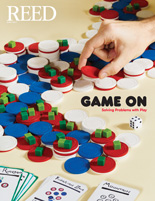
IRIS login | Reed College home Volume 96, No. 2: June 2017
Math Profs Win Grant to Stretch a World of Silly Putty

Prof. Osorno and Prof. Ormsby won a grant from the NSF to do research in homotopy theory, a branch of mathematics that uses the tools of algebra to explore the otherworldly terrain of topology. Photo by Chris Lydgate
Imagine an elastic, rubbery world where baseballs can be stretched into spaghetti, and coffee cups squeezed into wedding rings. Where our familiar intuitions about shapes, points, and proximity are given rigorous mathematical definitions—and then turned inside out, distorted into an alien universe of dazzling symmetries and dark infinities.
Welcome to homotopy theory, a peculiar domain where mathematicians use the relatively well-established tools of algebra to peek inside the fantastic terrain of topology.

GOOD FIBRATIONS. The Hopf fibration is a protean topological entity with deep implications for fields as diverse as geometry, fluid mechanics, and particle physics. Niles Johnson
Reed math professors Kyle Ormsby and Angélica Osorno have won a monster $368,000 grant from the National Science Foundation to explore this emergent field (pronounced HOME-uh-topy), which is populated by strange mathematical entities such as Hopf fibrations, Burnside rings, and infinite loop space machines.
In particular, they hope to cross-pollinate two distinct branches of the discipline—equivariant homotopy theory and motivic homotopy theory. “We hope to use insights from each field to bear on the other,” says Prof. Ormsby.
One of their projects has to do with an idea first proposed more than two centuries ago by the brilliant French mathematician Évariste Galois (1811-1832) when he was 18 years old (he was killed in a duel just two years later). Galois pointed out a symmetrical correspondence between two kinds of mathematical entities, groups and fields. This insight is now known as Galois theory, and has proven to be an extremely useful mathematical tool, yielding many deep and unexpected results. (Among them that there can never be a general formula for solving general quintic equations of the form ax5+bx4+cx3+dx2+ex+f = 0.)
What are the implications of looking at Galois theory from a homotopic perspective? “It’s a natural problem,” says Prof. Osorno. “Before you prove the theorem, you don’t know where it will lead.”
The full power of the field is only now being harnessed; equivariant homotopy theory was actually used in 2011 to crack a major problem in topology known as the “Arf-Kervaire invariant problem.” In fact, some of the most prominent researchers in homotopy theory will come to Reed in August for a conference titled “Homotopy Theory in the Ecliptic,” for which Reed won a separate grant from the NSF.
The NSF grant will also give students the opportunity to pursue their own research projects over the next few summers, potentially adding to the impressive list of student publications from Reed’s math department.


LATEST COMMENTS
steve-jobs-1976 I knew Steve Jobs when he was on the second floor of Quincy. (Fall...
Utnapishtim - 2 weeks ago
Prof. Mason Drukman [political science 1964–70] This is gold, pure gold. God bless, Prof. Drukman.
puredog - 1 month ago
virginia-davis-1965 Such a good friend & compatriot in the day of Satyricon...
czarchasm - 4 months ago
John Peara Baba 1990 John died of a broken heart from losing his mom and then his...
kodachrome - 7 months ago
Carol Sawyer 1962 Who wrote this obit? I'm writing something about Carol Sawyer...
MsLaurie Pepper - 8 months ago
William W. Wissman MAT 1969 ...and THREE sisters. Sabra, the oldest, Mary, the middle, and...
riclf - 10 months ago